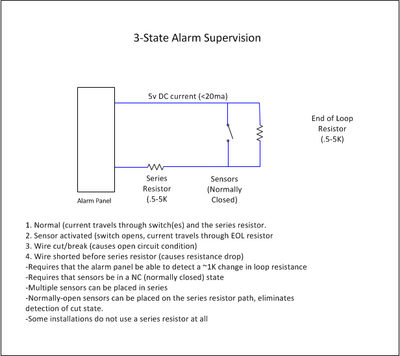Alarm and Sensor Technologies: Difference between revisions
Jump to navigation
Jump to search
| Line 6: | Line 6: | ||
====A basic alarm circuit==== | ====A basic alarm circuit==== | ||
Commercial alarm systems are typically wired up as follows: | Commercial alarm systems are typically wired up as follows: | ||
[[File:3-state_alarm_wiring.png|400px]] | |||
*One or more sensors are placed in series to form a "loop." Each loop forms a sensor zone. | *One or more sensors are placed in series to form a "loop." Each loop forms a sensor zone. | ||
*Sensor zones are always wired up as "normally closed" | *Sensor zones are always wired up as "normally closed" | ||
*Each zone includes a resistor in the middle of each loop, a resistor at the end of each sensor loop, and the ability to check voltage or resistance at the alarm panel. circuits. | *Each zone includes a resistor in the middle of each loop, a resistor at the end of each sensor loop, and the ability to check voltage or resistance at the alarm panel. circuits. | ||
<BR> | <BR> | ||
====Sensors==== | ====Sensors==== | ||
Revision as of 11:13, 14 May 2012
Overview of Alarm Technologies
The point of physical security measures is to provide a complete triangle of Deterrence, Detection, and Delay, ultimately leading to Response from the site personnel, police, etc.
Alarm technology exists to augment humans in meeting these goals. The typical alarm system includes overlapping sensors to check for door/open closed status, glass breakage, motion, and more. These sensors are electrically "supervised" by a microcontroller and monitored constantly for changes in state.
A basic alarm circuit
Commercial alarm systems are typically wired up as follows:
- One or more sensors are placed in series to form a "loop." Each loop forms a sensor zone.
- Sensor zones are always wired up as "normally closed"
- Each zone includes a resistor in the middle of each loop, a resistor at the end of each sensor loop, and the ability to check voltage or resistance at the alarm panel. circuits.
Sensors
- Passive Infrared (PIR)
This type of sensor is used to protect inside and outside spaces by watching for changes in radiated IR.
- Does a good job of detecting any type of motion by warm bodies
- Inexpensive and widely available
- Is vulnerable to false-alarms or deliberate attempts to set it off
- Wikipedia article on PIRs
- EEVblog teardown of a PIR
